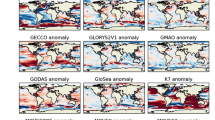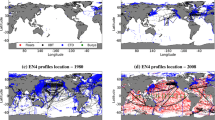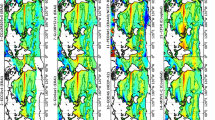Abstract
The Geophysical Fluid Dynamics Laboratory has developed an ensemble coupled data assimilation (ECDA) system based on the fully coupled climate model, CM2.1, in order to provide reanalyzed coupled initial conditions that are balanced with the climate prediction model. Here, we conduct a comprehensive assessment for the oceanic variability from the latest version of the ECDA analyzed for 51 years, 1960–2010. Meridional oceanic heat transport, net ocean surface heat flux, wind stress, sea surface height, top 300 m heat content, tropical temperature, salinity and currents are compared with various in situ observations and reanalyses by employing similar configurations with the assessment of the NCEP’s climate forecast system reanalysis (Xue et al. in Clim Dyn 37(11):2511–2539, 2011). Results show that the ECDA agrees well with observations in both climatology and variability for 51 years. For the simulation of the Tropical Atlantic Ocean and global salinity variability, the ECDA shows a good performance compared to existing reanalyses. The ECDA also shows no significant drift in the deep ocean temperature and salinity. While systematic model biases are mostly corrected with the coupled data assimilation, some biases (e.g., strong trade winds, weak westerly winds and warm SST in the southern oceans, subsurface temperature and salinity biases along the equatorial western Pacific boundary, overestimating the mixed layer depth around the subpolar Atlantic and high-latitude southern oceans in the winter seasons) are not completely eliminated. Mean biases such as strong South Equatorial Current, weak Equatorial Under Current, and weak Atlantic overturning transport are generated during the assimilation procedure, but their variabilities are well simulated. In terms of climate variability, the ECDA provides good simulations of the dominant oceanic signals associated with El Nino and Southern Oscillation, Indian Ocean Dipole, Pacific Decadal Oscillation, and Atlantic Meridional Overturning Circulation during the whole analyzed period, 1960–2010.























Similar content being viewed by others
References
Anderson JL (2003) A local least squares framework for ensemble filtering. Mon Weather Rev 131:634–642
Antonov JI et al (2010) World Ocean Atlas 2009, volume 2: salinity. In: Levitus S (ed) NOAA Atlas NESDIS 69. U.S. Government Printing Office, Washington, DC 184 pp
Balmaseda MA, Smith GC, Haines K, Anderson D, Palmer TN, Vidard A (2007) Historical reconstruction of the Atlantic Meridional Overturning Circulation from the ECMWF operational ocean reanalysis. Geophys Res Lett 34:L23615. doi:10.1029/2007GL031645
Bonjean F, Lagerloef GSE (2002) Diagnostic model and analysis of the surface currents in the tropical pacific ocean. J Phys Oceanogr 32:2938–2954
Boyer TP et al. (2009) World Ocean Database 2009, Chapter 1: introduction. In: Levitus S (ed) NOAA Atlas NESDIS 66. U.S. Gov. Printing Office, Washington, DC, 216 pp
Boyer TP, Levitus S, Antonov JI, Locarnini RA, Garcia HE (2005) Linear trends of salinity for the World Ocean, 1955–1998. Geophys Res Lett 32:L01604. doi:1029:2004GL021791
Carton JA, Santorelli A (2008) Global upper ocean heat content as viewed in nine analyses. J Clim 21:6015–6035
Chang YS, Rosati A, Zhang S, Harrison MJ (2009) Objective analysis of monthly temperature and salinity for the world ocean in the 21st century: comparison with World Ocean Atlas and application to assimilation validation. J Geophys Res 114:C02014. doi:10.1029/2008JC004970
Chang YS, Rosati A, Vecchi GA (2010) Basin patterns of global sea level changes for 2004–2007. J Mar Syst 80(1–2):115–124. doi:10.1016/j.jmarsys.2009.11.003
Chang YS, Rosati A, Zhang S (2011a) A construction of pseudo salinity profiles for the global ocean: method and evaluation. J Geophys Res 116:C02002. doi:10.1029/2010JC006386
Chang YS, Zhang S, Rosati A (2011b) Improvement of salinity representation in an ensemble coupled data assimilation system using pseudo salinity profiles. Geophys Res Lett 38:L13609. doi:10.1029/2011GL048064
Cunningham SA et al (2007) Temporal variability of the Atlantic meridional overturning circulation at 26.5°N. Science 317:935–938
de Boyer Montégut C, Madec G, Fischer AS, Lazar A, Iudicone D (2004) Mixed layer depth over the global ocean: an examination of profile data and a profile-based climatology. J Geophys Res 109:C12003. doi:10.1029/2004JC002378
Delworth TL et al (2006) GFDL’s CM2 global coupled climate model. Part I: formulation and simulation characteristics. J Clim 19:643–674
Delworth TL et al (2012) Simulated climate and climate change in the GFDL CM2.5 high resolution coupled climate model. J Clim 25:2755–2781
Di Lorenzo E et al (2008) North Pacific Gyre Oscillation links ocean climate and ecosystem change. Geophys Res Lett 35:L08607. doi:10.1029/2007GL032838
Ganachaud AS, Wunsch C (2003) Largo-scale ocean heat and freshwater transports during the World Ocean circulation experiment. J Clim 16:696–705
Garzoli SL, Baringer MO (2007) Meridional heat transport determined with expendable bathythermographs, Part II: South Atlantic transport. Deep Sea Res(I) 54(8):1402–1420
Gnanadesikan A et al (2006) GFDL CM2 global coupled climate models, Part II: the baseline ocean simulation. J Clim 19:675–697
Gouretski V, Kiltermann KP (2007) How much is the ocean really warming? Geophys Res Lett 34:L01610. doi:10.1029/2006GL027834
Gouretski V, Reseghetti F (2010) On depth and temperature biases in bathythermograph data: development of a new correction scheme based on analysis of a global ocean database. Deep Sea Res I 57(6):812–834. doi:10.1016/j.dsr.2010.03.011
Griffies SM et al (2005) Formulation of an ocean model for global climate simulations. Ocean Sci 1:45–79
Hakkinen S, Rhines PB (2004) Decline of subpolar North Atlantic circulation during the 1990 s. Science 304:325–340
Hanawa K, Raul P, Bailey R, Sy A, Szabados M (1995) A new depth-time equation for Sippican or TSK T-7, T-6 and T-4 expendable bathythermographs (XBT). Deep Sea Res I 42:1423–1451
Holfort J, Siedler G (2001) The Meridional oceanic transports of heat and nutrients in the South Atlantic. J Phys Oceanogr 31:5–29
Huang RX, Wang W, Liu LL (2006) Decadal variability of wind energy input to the world ocean. Deep Sea Res II 53:31–41
Huang B, Xue Y, Kumar A, Behring DW (2012) AMOC variations in 1979–2008 simulated by NCEP operational ocean data assimilation system. Clim Dyn 38:513–525. doi:10.1007/s00382-011-1035-z
Hunke EC, Dukowicz JK (1997) An elastic-viscous-plastic model for sea ice dynamics. J Phys Oceanogr 27:1849–1867
Ingleby B, Huddleston M (2007) Quality control of ocean temperature and salinity profiles historical and real-time data. J Mar Syst 65:158–175
Ishii M, Kimoto M (2009) Reevaluation of historical ocean heat content variations with time-varying XBT and MBT depth bias corrections. J Oceanogr 65(3):287–299. doi:10.1007/s10872-009-0027-7
Kalnay E et al (1996) The NCEP/NCAR 40-year reanalysis project. Bull Am Met Soc 77:437–471
Kanamitsu M, Ebitsuzaki W, Woolen J, Yang SK, Hnilo JJ, Fiorino M, Potter GL (2002) NCEP-DOE AMIP-II reanalysis (R-2). Bull Am Met Soc 83:1631–1643
Kizu S, Yoritaka H, Hanawa K (2005) A new fall-rate equation for T-5 Expendable Bathythermograph (XBT) by TSK. J Oceanogr 61:115–121
Klein B, Molinari RL, Muller TJ, Siedler G (1995) A trans-atlantic section at 14.5 N: meridional volume and heat fluxes. J Mar Res 53(6):929–957
Köhl A, Stammer D (2008) Variability of the meridional overturning in the North Atlantic from the 50-year GECCO state estimation. J Phys Oceanogr 38:1913–1930. doi:10.1175/2008JPO3775.1
Large WG, Yeager SG (2009) The global climatology of an interannually varying air-sea flux data set. Clim Dyn 33:341–364
Lavin A, Bryden HL, Parrilla G (1998) Meridional transport and heat flux variations in the subtropical North Atlantic. Glob Atmos Ocean Syst 6:269–293
Leuliette EW, Willis JK (2011) Balancing the sea level budget. Oceanography 24(2):122–129. doi:10.5670/oceanog.2011.32
Levitus S, Antonov JI, Boyer TP (2005) Warming of the World Ocean, 1955–2003. Geophys Res Lett 32:L02604. doi:10.1029GL021592
Levitus S, Antonov JI, Boyer TP, Locarnini RA, Garcia HE, Mishonov AV (2009) Global Ocean Heat Content 1955–2008 in light of recently revealed instrumentation problems. Geophys Res Lett 36:L07608. doi:10.1029/2008GL037155
Lin SJ (2004) A “vertically Lagrangian” finite-volume dynamical core for global models. Mon Weather Rev 132:2293–2307
Locarnini RA et al (2010) World Ocean Atlas 2009, volume 1: temperature. In: Levitus S (ed) NOAA Atlas NESDIS 68. U.S. Government Printing Office, Washington, DC, p 184
Lock AP, Brown AR, Bush MR, Martin GM, Smith RNB (2000) A new boundary layer mixing scheme. Part I: scheme description and single-column model tests. Mon Weather Rev 128:3187–3199
Lumpkin R, Sppeer K (2007) Global Ocean meridional overturning. J Phys Oceanogr 37:2550–2562
Macdonald AM (1998) The global ocean circulation: a hydrographic estimate and regional analysis. Prog Oceanogr 41:281–382
Macdonald AM, Wunsch C (1996) An estimate of global ocean circulation and heat fluxes. Nature 382:436–439
Mahajan S, Zhang R, Delworth TL, Zhang S, Rosati A, Chang YS (2011) Predicting Atlantic meridional overturning circulation (AMOC) variations using subsurface and surface fingerprints. Deep Sea Res 58(17–18):1895–1903. doi:10.1016/j.dsr2.2010.10.067
Mantua NJ, Hare SJ, Zhang Y, Wallace JM, Francis RC (1997) A Pacific interdecadal oscillation with impacts on salmon production. Bull Am Met Soc 78:1069–1079
Meehl GA et al (2009) Decadal prediction: can it be skillful? Bull Am Met Soc 90:1467–1485
Miller A, Cayan DR, Barnett TP, Graham NE, Oberhuber JM (1994) The 1976–77 climate shift of the Pacific Ocean. Oceanography 7:21–26
Moorthi S, Suarez MJ (1992) Relaxed Arakawa-Schubert: a parameterization of moist convection for general circulation models. Mon Weather Rev 120:978–1002
Rao SA, Behera SK, Masumoto Y, Yamagata T (2002) Interannual subsurface variability in the tropical Indian Ocean with a special emphasis on the Indian Ocean dipole. Deep Sea Res II 49:1549–1572
Rayner NA et al. (2003) Global analyses of sea surface temperature, sea ice, and night marine air temperature since the late nineteenth century. J Geophys Res 108(D14):4407. doi:10.1029/2002JD002670
Reynolds RW, Chelton DB (2010) Comparisons of daily sea surface temperature analyses for 2007–08. J Clim 23:3545–3562
Reynolds RW, Rayner NA, Smith TM, Stokes DC, Wang W (2002) An improved in situ and satellite SST analysis for climate. J Clim 15:1609–1625
Risien CM, Chelton DB (2008) A global climatology of surface wind and wind stress fields from eight years of QuickSCAT scatterometer data. J Phys Oceanogr 38:2379–2413
Saha S et al (2010) The NCEP climate forecast system reanalysis. Bull Am Met Soc 91:1015–1057
Sato OT, Rossby T (2000) Seasonal and low-frequency variability of the meridional heat flux at 36 N in the North Atlantic. J Phys Oceanogr 30:606–621
Schneider EK, Huang B, Zhu Z, DeWitt DG, Kinter JL III, Kirtman B, Shukla J (1999) Ocean data assimilation, initialization, and predictions of ENSO with a coupled GCM. Mon Weather Rev 127:1187–1207
Smith DM et al (2007) Improved surface temperature prediction for the coming decade from a global climate model. Science 317(5839):796–799. doi:10.1126/science.1139540
Speer KG, Holfort J, Reynard T, Siedler G (1996) South Atlantic heat transport at 11S. In: Wefer G, Berger WH, Siedler G, Webb DJ (eds) The South Atlantic: present and past circulation. Springer, Berlin, pp 105–120
Ssalto/Duacs User Handbook (2008) (M)SLA and (M)ADT Near-Real-time and Delayed-time Products, SALP-DU-P-EA-21065-CLS, Edition 1.9
Sugiura N et al (2008) Development of a 4-dimensional variational coupled data assimilation system for enhanced analysis and prediction of seasonal to interannual climate variations. J Geophys Res 113:C10017. doi:10.1029/2008JC004741
Talley LD (2003) Shallow, intermediate, and deep overturning components of the global heat budget. J Phys Oceanogr 33:530–560
Uppala SM et al (2005) The ERA-40 re-analysis. Q J R Meteor Soc 131:2961–3012. doi:10.1256/qj.04.176
Wang W, Xie P, Yoo SH, Xue Y, Kumar A, Wu X (2011) An assessment of the surface climate in the NCEP Climate Forecast System Reanalysis. Clim Dyn 37(7–8):1601–1620. doi:10.1007/s00382-010-0935-7
Wijffels SE, Willis J, Domingues CM, Barker P, White NJ, Gronell A, Ridgway K, Church JA (2008) Changing expendable bathythermograph fall rates and their impact on estimates of thermosteric sea level rise. J Clim 21:5657–5672
Willis JK, Chambers DP, Nerem RS (2008) Assessing the globally averaged sea level budget on seasonal to interannual timescales. J Geophys Res 113:C06015. doi:10.1029/2007JC004517
Winton M (2000) A reformulated three-layer sea ice model. J Atmos Ocean Tech 17:525–531
Wittenberg AT, Rosati A, Lau N-C, Ploshay JJ (2006) GFDL’s CM2 global coupled models. Part III: tropical pacific climate and ENSO. J Clim 19(5):698–722. doi:10.1175/JCLI3631.1
Xue Y, Huang B, Hu ZZ, Kumar A, Wen C, Behringer D (2011) An assessment of oceanic variability in the NCEP climate forecast system reanalysis. Clim Dyn 37(11):2511–2539. doi:10.1007/s00382-010-0954-4
Yang XY, Huang RX, Wang DX (2007) Decadal changes of wind stress over the southern ocean associated with Antarctic ozone depletion. J Clim 20:3395–3410
Yang SC, Keppenne C, Rienecker MR, Kalnay E (2009) Application of coupled bred vectors to seasonal-to-interannual forecasting and ocean data assimilation. J Clim 22:2850–2870
Yu L, Weller RA (2007) Objectively analyzed air-sea heat fluxes (OAFlux) for the global ocean. Bull Am Met Soc 88:527–539
Zhang R (2008) Coherent surface-subsurface fingerprint of the Atlantic meridional overturning circulation. Geophys Res Lett 35:L20705. doi:10.1029/2008GL0354623
Zhang S, Rosati A (2010) An inflated ensemble filter for ocean data assimilation with a biased coupled GCM. Mon Weather Rev 138:3905–3931. doi:10.1175/2010MWR3326.1
Zhang Y, Rossow W, Lacis A, Oinas V, Mishchenko M (2004) Calculation of radiative flux profiles from the surface to top-of-atmosphere based on ISCCP and other global data sets: refinements of the radiative transfer model and input data. J Geophys Res 109:D19105. doi:10.1029/2003JD004457
Zhang S, Harrison MJ, Rosati A, Wittenberg AT (2007) System design and evaluation of coupled ensemble data assimilation for global oceanic climate studies. Mon Weather Rev 135:3541–3564
Zhang S, Rosati A, Harrison MJ (2009) Detection of multidecadal oceanic variability by ocean data assimilation in the context of a “perfect” coupled model. J Geophys Res 114:C12018. doi:10.1029/2008JC005261
Zhang S, Rosati A, Delworth TL (2010) The adequacy of observing systems in monitoring the Atlantic meridional overturning circulation and North Atlantic climate. J Clim 23:5311–5324
Zhang S, Liu Z, Rosati A, Delworth TL (2012) A study of enhancive parameter correction with coupled data assimilation for climate estimation and prediction using a simple coupled model. Tellus A 64:10963. doi:10.3402/tellusa.v64i0.10963
Acknowledgments
We greatly appreciate research groups on OAFlux, ISCCP, ERA40, NODC, TAO, OSCAR, AVISO, EN3, and RAPID for providing their analysis based on observations. The availability of NCEP reanalysis, OISST, WOD09, Argo and GTSPP data also makes the ECDA system possible. We thank R. Msadek and X. Yang for their comments on the earlier version of this manuscript. Suggestions made by two anonymous reviewers were very constructive in the revision of this paper.
Author information
Authors and Affiliations
Corresponding author
Rights and permissions
About this article
Cite this article
Chang, YS., Zhang, S., Rosati, A. et al. An assessment of oceanic variability for 1960–2010 from the GFDL ensemble coupled data assimilation. Clim Dyn 40, 775–803 (2013). https://doi.org/10.1007/s00382-012-1412-2
Received:
Accepted:
Published:
Issue Date:
DOI: https://doi.org/10.1007/s00382-012-1412-2




